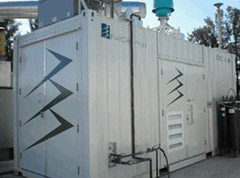Sustainable Water Infrastructure Contacts
Pacific Southwest, Region 9
Serving: Arizona, California, Hawaii, Nevada, Pacific Islands, Tribal Nations
Water & Energy Efficiency in Water and Wastewater Facilities
| Sustainable Water Infrastructure Quick Finder | ||||
|---|---|---|---|---|
| FundingGreen Jobs in the Water SectorLow Impact Development | Waste To Biogas Mapping ToolWater Conservation/EfficiencyWater-Energy Connection | Water Loss ControlWhy Sustainability? | ||
Environmental Benefits

Success Stories:
Energy and the environment are closely linked, so improving your facility's energy efficiency not only saves you money, but it also saves important natural resources. Significant environmental benefits gained by adopting energy efficient technologies and processes include:
- lowering the demand for natural resources
- reducing the emission of air pollutants
- improving water quality
- reducing the accumulation of solid waste, and;
- reducing climate change impacts.
Improving energy conservation at your facility can improve your facility's overall efficiency, which leads to a cleaner environment.
Poorly functioning or non-functioning wastewater facilities pollute of creeks, rivers, and coastal waters, damage fragile aquatic resources such as coral reefs, and endanger the public health and safety of neighborhood residential areas. Wastewater also contains nutrients which can stimulate the growth of aquatic plants and algae, reducing the clarity of the water and the availability of oxygen, which threatens aquatic life and transforms once healthy coral reefs into damaged ecosystems covered in seaweed and algae.
- Millbrae, CA
 is an example of a facility that is more energy efficient while also improving water quality performance because grease causes sewage overflow spills when it clogs up sewer lines, releasing raw sewage into the environment. By finding a way to use the grease to produce fuel that powers the wastewater treatment facility, they demonstrate that energy efficiency can also improve treatment performance.
is an example of a facility that is more energy efficient while also improving water quality performance because grease causes sewage overflow spills when it clogs up sewer lines, releasing raw sewage into the environment. By finding a way to use the grease to produce fuel that powers the wastewater treatment facility, they demonstrate that energy efficiency can also improve treatment performance.
By conserving energy, facilities will reduce their fossil fuel use and so reduce emissions that contribute to global warming and acid rain. Some facilities are leading the way. The Inland Empire Utilities Agency's ![]() Ontario, CA facility upgraded in 2001. In designing the upgrade, Inland Empire evaluated the energy efficiency of their pumping system. They retrofitted pumps with high efficiency motors, improving equipment life and increasing pump efficiency. The result? They cut energy use by 475,000 kWh, saved $57,000 in annual energy costs and an additional $14,000 in annual maintenance costs, and eliminated 200,000 pounds of greenhouse gas emissions.
Ontario, CA facility upgraded in 2001. In designing the upgrade, Inland Empire evaluated the energy efficiency of their pumping system. They retrofitted pumps with high efficiency motors, improving equipment life and increasing pump efficiency. The result? They cut energy use by 475,000 kWh, saved $57,000 in annual energy costs and an additional $14,000 in annual maintenance costs, and eliminated 200,000 pounds of greenhouse gas emissions.
- The Sonoma County, California wastewater treatment facility
 now relies on renewable energy. They installed two solar electric power systems, which produce more than 1.5 megawatts. The county estimates these solar panels will help reduce global warming by displacing over 37.5 million pounds of carbon dioxide emissions annually.
now relies on renewable energy. They installed two solar electric power systems, which produce more than 1.5 megawatts. The county estimates these solar panels will help reduce global warming by displacing over 37.5 million pounds of carbon dioxide emissions annually.
Combined heat and power (CHP), also known as co-generation, is an efficient, clean, and reliable approach to generating power and thermal energy from a single fuel source. Wastewater treatment facilities with anaerobic digesters create methane gas as a by-product. Currently, a number of these facilities release methane gas by flaring, converting methane to CO2 and releasing it into the atmosphere. Methane gas, however, is a good source of energy. Using the methane, rather than simply flaring it as a waste gas, not only saves a facility money, but can greatly reduce that facility's annual emissions. For example, the Clearwater Cogeneration Wastewater Treatment Facility ![]() installed a co-generation system and a thermal oven. Working together, these two installations reduced the volume of biosolids by 80%. By reducing the amount of biosolids, the facility also reduced the environmental impacts associated with disposing of the biosolids, including less greenhouse gases emitted from landfills, fewer emissions from the heavy vehicles that transport the waste, and less pollution caused by litter and spills, and loading of the landfill components.
installed a co-generation system and a thermal oven. Working together, these two installations reduced the volume of biosolids by 80%. By reducing the amount of biosolids, the facility also reduced the environmental impacts associated with disposing of the biosolids, including less greenhouse gases emitted from landfills, fewer emissions from the heavy vehicles that transport the waste, and less pollution caused by litter and spills, and loading of the landfill components.
- The Los Angeles County Sanitation District has four facilities that have installed co-generation units. These include fuel cells, microturbines, and reciprocating engines. The environmental benefits associated with these facilities are significant as illustrated in the LA County Sanitation District's Web sites. LA County regularly estimates
 the accumulated cost and energy savings with their Demand Side Resource Management Program.
the accumulated cost and energy savings with their Demand Side Resource Management Program. 

The environmental benefits of adopting energy conservation measures can be significant. A facility can make a number of small changes that add up to major energy reductions, and/or make a large investment in new energy efficient equipment and processes. Either way, you can achieve measurable and meaningful environment benefits by doing your part.
- The Dublin San Ramon Services District completed an upgrade to its Regional Wastewater Treatment Facility (PDF) (2 pp, 242K)
 which significantly reduced its energy costs. Since aeration fans can use as much as 50% of total energy use, the facility increased aeration blower capacity and installed single stage aeration fans which use 31% less energy. It also installed high efficiency pump motors and a UV lamp disinfection system, all of which resulted in both a $290,000 reduction in energy costs while increasing the facility’s treatment capacity by 48%.
which significantly reduced its energy costs. Since aeration fans can use as much as 50% of total energy use, the facility increased aeration blower capacity and installed single stage aeration fans which use 31% less energy. It also installed high efficiency pump motors and a UV lamp disinfection system, all of which resulted in both a $290,000 reduction in energy costs while increasing the facility’s treatment capacity by 48%.
